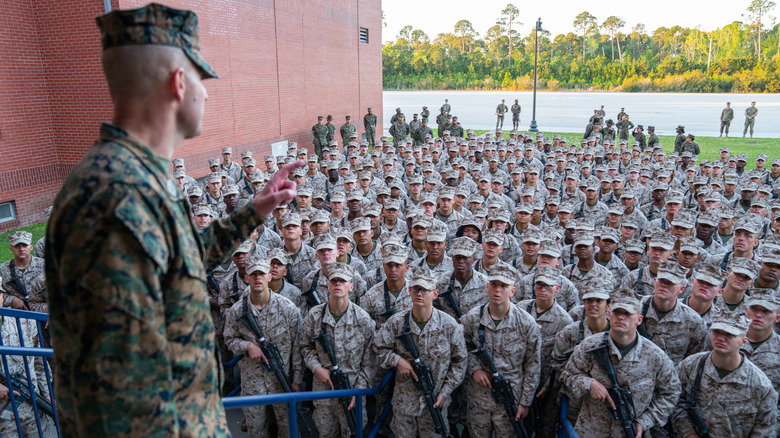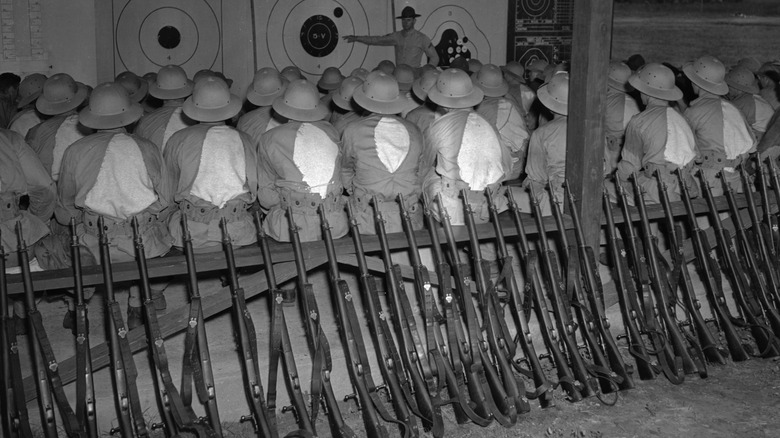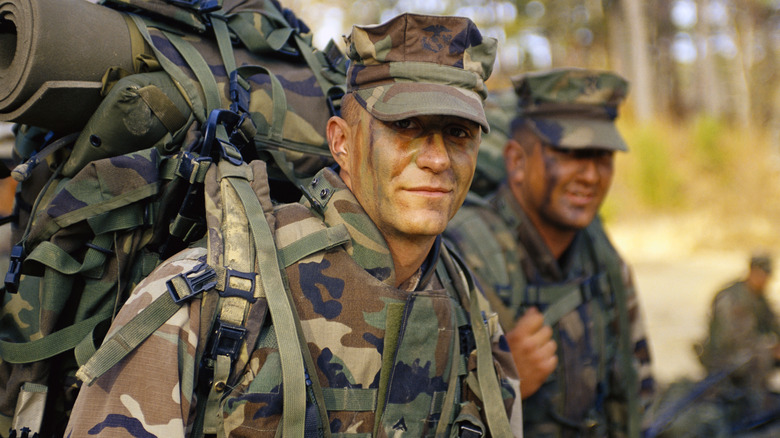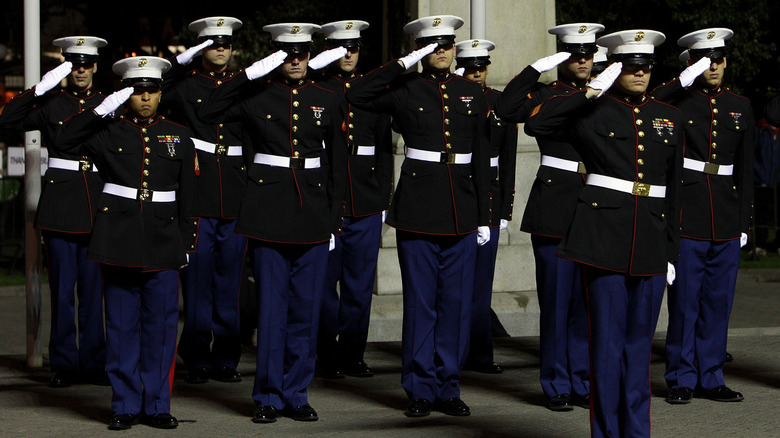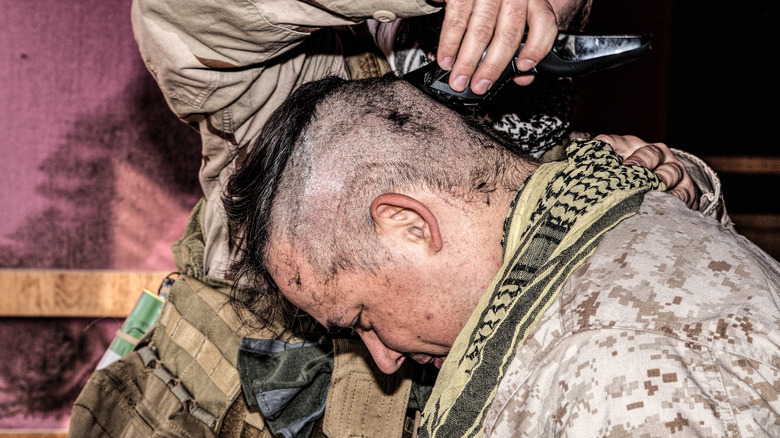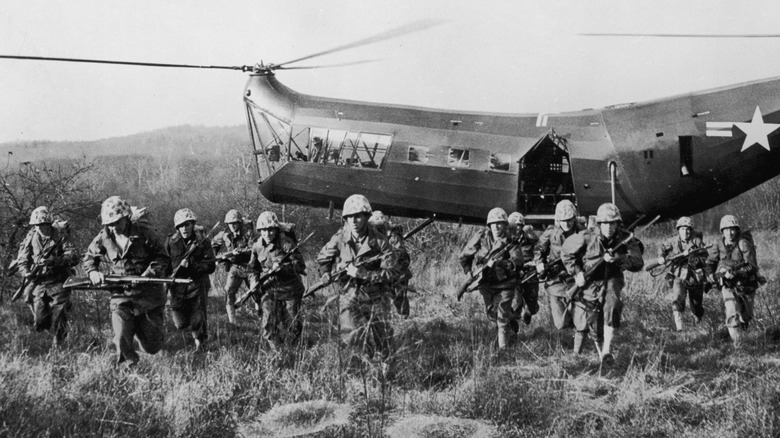Strict Rules U.S. Marines Have To Follow
In 2016, the United States Marine Corps discussed fading out their oft-used and oft-quoted recruiting slogan, "The Few. The Proud. The Marines." As catchy and famous as it was, and as useful as it was in setting the Marines apart from the rest of the U.S. military, recruiters told The Marine Times that the slogan "doesn't say anything about what we do or why we exist." New slogans, such as "Made for this," have taken over in the branch's advertising, and, while it's almost certainly not due to the slogan switch, the Marines have seen record numbers of reenlistments.
But "the few, the proud" does remain an accurate descriptor for the Marines, who have always held themselves apart from the rest of the U.S. military. With a history and tradition dating back to the Revolutionary War, the Marines have built up quite the reputation as a fighting force. They stole gunpowder from the British in 1776, decimated German and Japanese forces in World Wars I and II respectively, and engaged in major combat operations in Vietnam, Afghanistan, and Iraq. Their ferocity and relentlessness have earned them a slew of nicknames, from "Devil Dogs" by the Germans to "jarheads" by rivals in the U.S. Navy.
Furthering its sense of exclusivity, the Marine Corps' "about" section on its website declares: "Comprised not of a brotherhood or sisterhood — this is a warriorhood." And this exclusive group within the military has its traditions and rules that its members are expected to abide by. Read on to learn more about just a few of those rules.
The Marines have stricter entry requirements than other military branches
Every branch of the U.S. military has certain educational, technical, and physical requirements for those who would join up. Only U.S. citizens or green-card holders fluent in English can enlist, and a high school education or equivalent is a must. But the Marines have a tighter set of requirements than the rest of the military.
As the branch that puts such a premium on its fighting capability, the Marines have a narrow age range for those who want to enlist. Every branch opens enlistment to those over the age of 17. The Army's cutoff is 35 years old, and the rest of the branches are open to those in their early 40s. But for the Marines, the oldest you can be to enlist is 28. Those Marines who wish to make officer must be at least 20 years old.
The physical conditioning for the Marines is likewise a tough bar to clear. The initial strength test asks male applicants to do three pull-ups or 34 push-ups in two minutes, a 1.5-mile run within 13 1/2 minutes, and a 40-second plank. Female applicants must manage one pull-up or 15 push-ups, the same run within 15 minutes, and the same plank. As for the Marine Corps Physical Fitness Test, or PFT, it subjects Marines to two minutes of crunches, pull-ups and push-ups to the maximum repetition, and a timed 3-mile run, the most asked of any branch of the military.
Treat Never Keep Keep enforces weapons safety
The U.S. Marines' identity as a fighting force is central to their duties and self-promotion. Variations of "fight," "battle," and "warrior" are all over their online material. So too is a call to uphold the standards and values of the Corps. As one would hope for the world's most powerful military, the Marines and all branches of the military count firearm safety among their core standards. They share key instructions and guidelines for the handling of their weapons, phrased slightly differently. For the Army, it's the acronym "THINK"; for the Marines, it's the saying "Treat Never Keep Keep."
That saying on safety rules for firearms breaks down thusly: Treat every gun as if it were loaded; never point a weapon without intending to fire it; keep your finger off the trigger until you're ready to fire; and keep the safety engaged until you are ready to fire. Beyond these basics, Marines are drilled on the proper way to carry their weapons and store their ammunition, and how to position their weapons in various situations of escalating threat levels.
Warrant Officer Ron Hathaway added another rule to "Treat Never Keep Keep" in an instructional video for the Marines' website: "Know your target and what lies beyond and in between." He also stressed the responsibility of every member of the Corps to abide by safety rules, including the housing of weapons. Anyone living in barracks with the rank of sergeant or below must keep their weapons in the armory; weapons stored on base must be locked away and kept with their registration forms.
Marines can't wear cammies in public
The dress uniform of a U.S. Marine is impressive, cutting a striking feature with the contrast of dark and light and the "blood stripe" distinguishing officers above a certain rank. But red, white, and blue uniforms with immaculate and sharply delineated colors aren't going into combat. In the field, you'll see Marines wearing the combat utility uniform with a camouflage pattern (pictured), colloquially known as "cammies."
But you aren't likely to see Marines wearing their cammies away from active duty. In 2007, new regulations were issued governing how Marines should present themselves, whether they were on duty or not. A professional and uniform appearance is a prime concern for the Marines, and several of the prohibitions seem like no-brainers to that end: Marines were forbidden from having gem-studded teeth or going out with a bare midriff. But in the name of a proud countenance in public, the cammies, which had long been banned as off-base wear with exceptions made for brief stops, were now forbidden to be worn in any off-base situation outside of an emergency.
The penalty for violating the regulations on public wear is relatively minor; repeated infractions can get a Marine stuck on base with a pay cut. But having to keep out of sight while in cammies can be an inconvenience. Marines en route from work to home who don't have a chance to change can't get out of their cars to pump gas or pick up a meal. When the regulations were enacted, fast food restaurants near bases reported a spike in drive-thru line lengths.
Marines can't have their hands in their pockets
Restricting which uniforms can be worn in public is perhaps the most visually obvious rule the U.S. Marines have in the name of a proud, uniform, and professional appearance, but it's far from the only one. You may have noticed, if you've ever been in direct contact with a Marine, that their hands are always out in plain sight, never tucked away in their pockets. Sailors in the Navy can put their hands away, but Marines can't. That is by design. Marine regulations forbid them from putting their hands in their pockets unless they need to retrieve something — in a "garrison environment," per the text of the regulation on the Marines' website.
That detail of environment would seem to suggest that Marines don't have to rigidly adhere to the rule about not using pockets all the time. There was even an entire article published in the military-focused online magazine Task & Purpose in 2021 examining the wording of the regulation, with the conclusion that an improper use of semicolons made the pocket ban seem like an ironclad rule without the exceptions granted for other image regulations. But the Marines have declined opportunities to relax their interpretation of the pocket rule in the past, and commanders have often been unyielding.
Some commanders, at least. Others have told their command that, in harsh weather or cold conditions, there's no point in exposing your hands for the sake of a uniform appearance. In those cases, one commander told his troops in Iraq (per Business Insider), "forget the rule."
Reflective clothing is needed for low-light situations
Combat Center Order 1630.8D specified that any member of the U.S. Marine Corps who was engaged in activity outside of military formations and during hours of low visibility was required to wear reflective material. (The Marine Corps War College designated 1600 to 0800, or 4 p.m. to 8 a.m., as the hours reflective gear was required at Marine Corps Base Quantico, for example.) Road guards responsible for formation runs faced the same requirement. A belt or a vest was suggested, but Major Kim Keefer of the Marine Corps Air Ground Combat Center said that anything would work "as long as the clothing has reflective material and you can be seen by people driving" (per the Command Center website).
This clothing regulation isn't about maintaining a certain appearance but about safety. Marines, just like anybody who steps outside for physical training in low light, run the risk of an accident with a vehicle that can't see them. Mandatory reflective clothing was meant to minimize accidents, though the scope of the rule has been relaxed over time at some bases. At one point, Marines at Marine Corps Base Quantico were required to wear reflective clothing any time they went out biking, running, walking, or jogging; it was later amended to low light and low visibility.
The Marines haven't just made use of reflective material for safety. A force sent to Australia along with French troops struggled during training in heavily vegetated terrain. To work around the reduced visibility, Marines attached reflective belts onto drones to aid in maneuvers.
Haircuts are regulated (but they're not required every week)
It's a go-to scene for movies, TV shows, and cartoons that spoof military life: the almost-ritual shaving of new recruits' hair. Soldiers wearing their hair short, just shy of clean-shaven, is a long-standing tradition. Some sources trace it back to the Civil War, when shaving soldiers was an effective way to combat lice outbreaks. It's endured, becoming a rite of passage for new recruits, at least for men, though there is still some practicality behind the haircut. The longer a soldier's hair, the greater chance it obscures vision or gets caught in something.
For their male recruits, the Marine Corps has taken the tradition of short hair and regulated specific cuts, lengths, and fades. What the Marines' website refers to as the "bulk of hair" can't be any longer than 2 inches in length, and no section can exceed 3 inches. Hair long enough to part must be parted off center. Hair dye must be a natural shade if used, sideburns are forbidden, and any style must be blended or faded, without a sharp angle. Women serving in the Marines are permitted more variety in hair length, and if their hair is long enough, they can wear half-ponytails or half-braids.
Male Marines have to get plenty of haircuts within a year to keep their hair within regulations. But contrary to claims spread far and wide on the ever-so-reliable internet, Marines do not have to get their hair cut every week. In fact, there is no rule at all about how often you cut your hair, so long as it's well groomed and short enough.
Marines should never surrender if they have any means of resisting
The U.S. Marines, and all branches of the U.S. military, are required to act under the country's Code of Conduct, which was first developed after the Korean War. A combination of law and tradition, the code spelled out the expectations and obligations of serving military personnel on matters of combat and captivity, be that the treatment of prisoners of war taken by the United States or the behavior of American forces when in captivity. It came into force through an executive order issued by President Dwight D. Eisenhower, no stranger to combat situations himself, and was immediately incorporated into military training.
Considerable attention was paid in the Code of Conduct to preparing American troops for the possibility of capture and imprisonment, based on the experiences of POWs from the Korean War who ended up cooperating with the North Korean government. The code instructs Marines, and all fighting men and women, to "never surrender of [their] own free will." Commanders are urged to "never surrender the members of [their] command" if there is any reasonable chance that resistance can hold out.
In the event that they are captured, American soldiers are instructed to resist by any means, attempt escape whenever possible, refuse parole, and provide no information beyond their own name, rank, service number, and date of birth. Above all, they are taught to keep faith with the United States and betray no loyalty to their country.
The laws of war dictate Marine conduct on the battlefield
There is no way to make war anything other than the violent and grueling horror that it is, but mankind has tried to set rules to warfare from the earliest days of civilization. Since the mid-19th century, there has been a general consensus among the nations of the world that there must be some commonly accepted rules of conduct in combat. The Geneva Convention of 1864, which includes a number of rules soldiers have to follow during war, is the foundation of modern international law governing war. These laws of war are not binding, so they are sadly often ignored and difficult to enforce, but they remain as a professed commitment to humane conduct in dire straits, and there has been some success at implementing them.
The United States, while not a party to the International Court of Justice tied to the laws of war, supports the institution and the notion of international law. The laws of war, both their history and current understanding, are taught to all branches of the U.S. military, including the Marines. Handbooks issued to new recruits and students in the Marines explain some of the fundamental tenets of the laws of war. They are taught to apply proportionality (that is, the force used in combat cannot be disproportionate to what is needed), to avoid causing unnecessary suffering, to resist using illegal tactics like reprisals, and other matters. Violations of the laws of war by American troops has resulted in prosecutions.
For more on military rules and conventions, read our feature on strict rules Green Berets have to follow.

